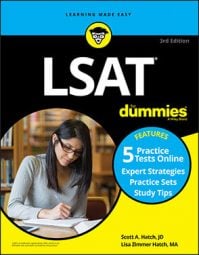If you see statistics used to promote an argument on the LSAT, look for an answer that shows whether the statistics actually relate to the conclusion’s topic. If they do, you’ll strengthen the conclusion. On the other hand, an answer that shows the statistic is unrelated to the conclusion significantly weakens that conclusion. The following is an example of a statistical logical reasoning question you could find on the LSAT:
In a survey of 100 pet owners, 80 percent said that they would buy a more expensive pet food if it contained vitamin supplements. Consequently, CatCo’s new premium cat food should be a top seller.
Which one of the following, if true, would most weaken the author’s argument?
(A)Some brands of cat food contain more vitamin supplements than CatCo’s does.
(B)CatCo sells more cat food than any of its competitors.
(C)Some of the cat owners surveyed stated that they never buy expensive brands of cat food.
(D)Ninety-five of those pet owners surveyed did not own cats.
(E)Many veterinarians have stated that vitamin supplements in cat food do not greatly increase health benefits.
Because the argument hinges on statistics, eliminate answers that don’t directly address the statistical evidence. Those surveyed stated they would pay more for pet food with vitamin supplements, but they didn’t provide information on whether the amount of vitamin supplements was important. So even though Choice (A) may entice you, it isn’t the best answer because it doesn’t address the statistics used in the argument.
Choice (B) doesn’t regard the survey results either, and it seems to support the conclusion rather than weaken it. The argument has nothing at all to do with veterinarians, so Choice (E) can’t be right. Only Choice (C) and Choice (D) deal with the survey the author uses to reach the conclusion that CatCo’s premium cat food will be a big seller.
You can eliminate answer choices that show there’s an exception to the statistical evidence. Exceptions don’t significantly weaken a statistical argument.
Therefore, Choice (C) is wrong and Choice (D) is the best answer because it demonstrates a weakness in the statistics the author uses to support the conclusion. The preferences of dog or bird owners wouldn’t be a good indicator of the habits of cat owners.
Strengthen/weaken questions lend themselves quite well to the technique of trying to answer the question before reading the answers. If you can identify the conclusion, take a moment to think about how you’d answer the question if you didn’t have an array of answers to choose from. Consider what the author is claiming, and then consider how you’d strengthen it, weaken it, or whatever the question wants you to do.

